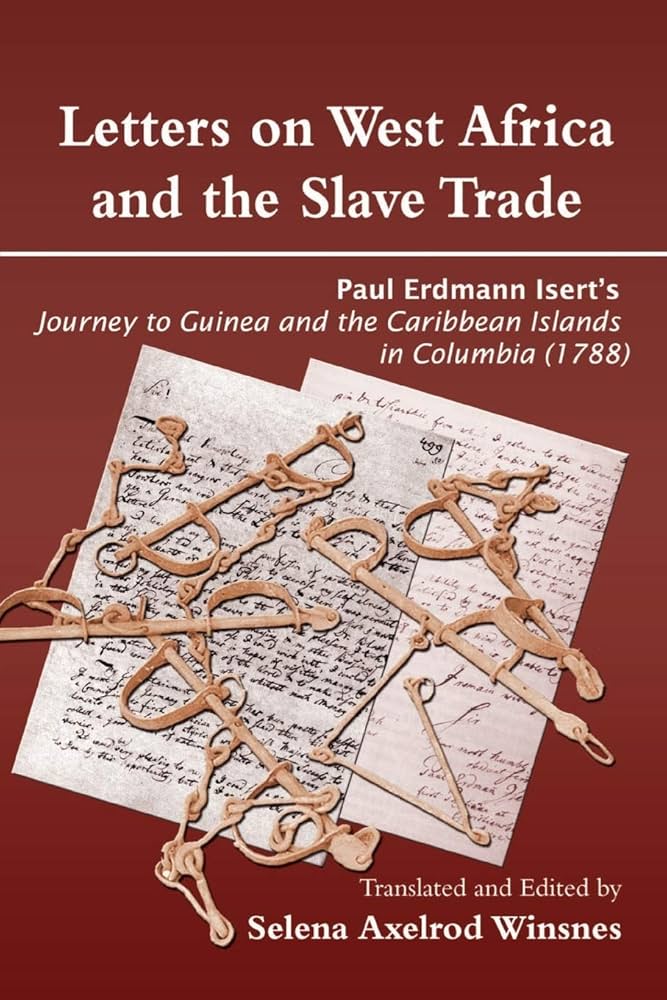
Book review: Chapter-by-Chapter Breakdown Of Paul Erdmann Isert’s Letters on West Africa and the Slave Trade (1788)
Chapter-by-chapter analysis and a searchable crop catalogue from Isert’s Letters (1788). Evidence-based excerpts on sugar, coffee, cotton, indigo, yams, plantain, and palm—plus implementable takeaways for Africa-based value chains.
Highlights:
-
-
Frederiksnopel concept: Isert returned in 1788 to found a model plantation colony at Akropong (Akuapem); cotton, tobacco, indigo and vegetables were planted; laborers were to be serfs with due legal protections (property, family life, court access).
-
Instruction set: early prohibition on planting sugar (despite the ultimate aim of sugar production) until food self-sufficiency was secured.
-
Chapter-by-Chapter Breakdown (with agricultural highlights)
Prefatory materials (editorial framing)
-
Frederiksnopel concept: Isert returned in 1788 to found a model plantation colony at Akropong (Akuapem); cotton, tobacco, indigo and vegetables were planted; laborers were to be serfs with due legal protections (property, family life, court access).
-
Instruction set: early prohibition on planting sugar (despite the ultimate aim of sugar production) until food self-sufficiency was secured.
-
Site strategy: Isert wanted a healthier mountain site; Copenhagen preferred Volta River access (for logistics and trade).
Letters I–IX (coast, wars, ethnography; background to agriculture)
-
Maize on the coast; palm-oil cookery: “Indian corn … oil cake … kummy (kankis), gigi (stiff porridge), flatta (soured gruel).” (Foodways + processing knowledge)
-
Editor’s introduction & index signposts also map where cotton, sugar, coffee and cultivation appear across the letters.
Letter X (Akuapem, heart of the agricultural case)
-
Productivity & cropping system: “Everything he plants he harvests more than a hundredfold … children plant maize, yams; cultivate plantains/bananas; tap palm-wine.”
-
Yam tech: yam as bread/starch; Isert extracts starch and notes alcoholic fermentation potential.
-
Plantain processing: fufu/“foi foi” method, palm-nut soup (oil palm as culinary fat).
Letter XI (St. Croix; abolitionist economics)
-
Classic programmatic passage: do not give up sugar/coffee/chocolate, rather grow those products in Africa to end the “shameful exportation of Blacks.”
Letter XII (Martinique/Guadeloupe; comparative agronomy)
-
Sugar quality & environment: marshy ground makes cane “too watery” (lower sugar; poorer rum).
-
Intercropping method: “coffee and cotton … planted together, one below the other.” (explicit agronomic practice)
-
Plantain plantation observation: density, fertilization, a stem with “252 plantains.”
Appendices (Frederiksnopel design; aftermath)
-
Colony scheme: legal/status protections for serfs; ombudsman for rights; mission-civilizing layer; post-Isert administrative headwinds and decline.
Searchable Crop-by-Crop Catalogue (quotes + page anchors)
Short, searchable entries. Use this like a field guide for building literature reviews or lectures.
| Crop | Where in Text (Letter/Appendix) | Short quotation (≤25 words) | Practical Angle |
|---|---|---|---|
| Sugarcane | XII (Guadeloupe) pp. 264–265 | “Sugar … too watery … lower sugar … rum … of inferior quality here.” | Match crop to drainage/soil; elevate sites or choose drier tracts. |
| XI (Program) pp. 338–339 | “Plantations of these products in Africa … stop the shameful exportation of Blacks.” | Import substitution in Africa for abolitionist economics. | |
| Appx. 3 (Instructions) p. 295 | “Prohibited … sugar … though the ultimate aim.” | Phase 1: food first; Phase 2: sugar. | |
| Coffee | XII (Guadeloupe) p. 264 | “coffee and cotton … planted together, one below the other.” | Intercropping blueprint; shade tiers; labor sharing. |
| XI (Program) p. 338 | “Should we break our habit of using sugar, coffee, chocolate …? No … plant … in Africa.” | Targets coffee explicitly for African production. | |
| Cotton | XII (Guadeloupe) p. 264 | “coffee and cotton … planted together, one below the other.” | Pair with coffee; staggered canopies. |
| Appx. 3 (Akropong) p. 345 | “Colonial crops such as cotton, tobacco and indigo … were planted.” | Proof of concept at Frederiksnopel. | |
| Indigo | Appx. 3 (Akropong) p. 345 | “indigo … planted.” | Dye crop for textiles; niche/heritage markets. |
| Tobacco | Appx. 3 (Akropong) p. 345 | “tobacco … planted.” | Early cash crop option (local & export). |
| Cocoa (cacao) | XI–XII index refs (pointers) | Index: “cocoa 244, 261, 264, 272; coffee 244…273.” | Signals Isert’s Caribbean crop set he wants replicated in Africa. |
| Maize (Indian corn) | VIII (Coast) p. 205 | “Oil cake … kummy/kankis, gigi, flatta.” | Milling/fermentation food industry know-how. |
| Yam | X (Akuapem) pp. 288–289 | “Starch from yam … spirituous fermentation.” | Inputs for starch and alcohol value chains. |
| Plantain/Banana | X (Akuapem) p. 290 | “Pounded plantain balls … called foi foi.” | Processing → ready-to-eat staples. |
| Palm (oil/palm-wine) | X (Akuapem) pp. 290–292 | “Palm-nut soup … palm-wine tapping and yields.” | Fats/beverages; household tech that scales. |
Thematic Synthesis: What Isert is actually proposing
-
Agricultural substitution for slavery: keep African labor in Africa, plant sugar, coffee, cotton, indigo, cacao “there” and end the Middle Passage’s economic rationale.
-
Staged development: secure food self-sufficiency first (maize, yam, plantain, palm), then scale export cash crops (sugar later, plus cotton, coffee, indigo, tobacco).
-
Agro-technical realism: match crop ⇄ environment (drainage for cane; elevation/shade for coffee; intercropping with cotton).
-
Governance & labor regime: regulated serfdom (property, family, court access) + ombudsman—a (flawed) attempt to de-brutalize coercive labor.
Implementable Takeaways (today)
-
Build Africa-based value chains that mirror Isert’s substitution logic: incentivize local processing of coffee/cocoa/cotton; target export-grade standards and traceability.
-
Site selection matters: follow Isert’s environmental notes—drainage for cane; mountain microclimates for quality coffee; intercropping coffee/cotton for canopy & labor efficiency.
-
Food security first: scale staple processing (yam starch, plantain RTD staples, palm-oil products) before expanding export acreage.
-
Labor standards by design: codify protections (ombudsman/worker advocate; due process; family stability) as investment requirements—modern ESG analogue.
Quick Tables
1) Crop → Opportunity → Modern Parallel
| Crop | Isert’s Opportunity | Modern Parallel |
|---|---|---|
| Sugar | Africa-based cane to replace slave-grown sugar. | Cane + beet portfolios; African refining capacity. |
| Coffee | Intercrop with cotton; suitable in hills. | Shade coffee, agroforestry models. |
| Cotton | Companion to coffee; planted at Akropong. | Sustainable cotton (BCI), verticalized textiles. |
| Indigo | Planted at Akropong. | Natural dyes, eco-fashion. |
| Cacao | Caribbean benchmark to transplant to Africa. | Move from beans → finished chocolate. |
| Yams/Plantain/Palm | Staple base & processing know-how. | Food industry (starches, flours, RTD staples, oils). |
2) Region & Suitability (Isert’s cues)
| Region | Suitability cues | Notes |
|---|---|---|
| Akuapem (hills) | “Healthier in the forest/mountains”; labor & staples abundant; potential for coffee. | Isert’s chosen colony site. |
| Volta lowlands | Logistics to river; caution on marshy cane quality. | River access v. agronomic risk. |
Bibliographic Notes for All Citations
-
Frederiksnopel plan / labor rights / early crop mix (cotton, indigo, tobacco): Appendix 3 commentary & materials.
-
Akuapem foodways, yields, processing (Letter X): staples, starch/fermentation, plantain “foi foi”, palm-nut soup/palm-wine.
-
Coastal maize processing (Letter VIII): kummy/kankis, gigi, flatta; p. 205.
-
Comparative agronomy (Letters XI–XII): African substitution for Caribbean crops; sugar/waterlogging; coffee–cotton intercropping; plantain plantation observation.
-
Index wayfinding for crop pages: cocoa/coffee/cotton/sugar/cultivation entries.
Note on “paragraph numbers”: the edition paginates continuously and our citations use page + line ranges from the digital text, which is more precise than paragraph numbering in this file.
Topics for further exploration (cross-disciplinary, applicable)
-
Abolitionist economics: import-substitution via African agro-industry; financing models.
-
Agroecology & climate matching: drainage/soil physics for cane; shade/altitude for coffee; intercrop architectures.
-
Food-processing tech transfer: yam starch extraction; plantain RTD staples; small-scale oil pressing.
-
Labor governance & ESG: translating Isert’s “ombudsman/serf rights” into modern third-party grievance systems.
-
Supply-chain design: from beans/bolls to finished chocolate/textiles in-country.
Metadata
-
Title: Gold Coast Agriculture in Paul Erdmann Isert’s Letters on West Africa (1788): Sugar, Coffee, Cotton, Indigo & an Abolitionist Economy
-
Meta description: Chapter-by-chapter analysis and a searchable crop catalogue from Isert’s Letters (1788). Evidence-based excerpts on sugar, coffee, cotton, indigo, yams, plantain, and palm—plus implementable takeaways for Africa-based value chains.
-
Keywords: Paul Erdmann Isert, Gold Coast agriculture, Frederiksnopel, coffee cotton intercropping, sugar drainage, yam starch, plantain fufu, palm-oil West Africa, abolitionist economics, sustainable agribusiness Ghana.

